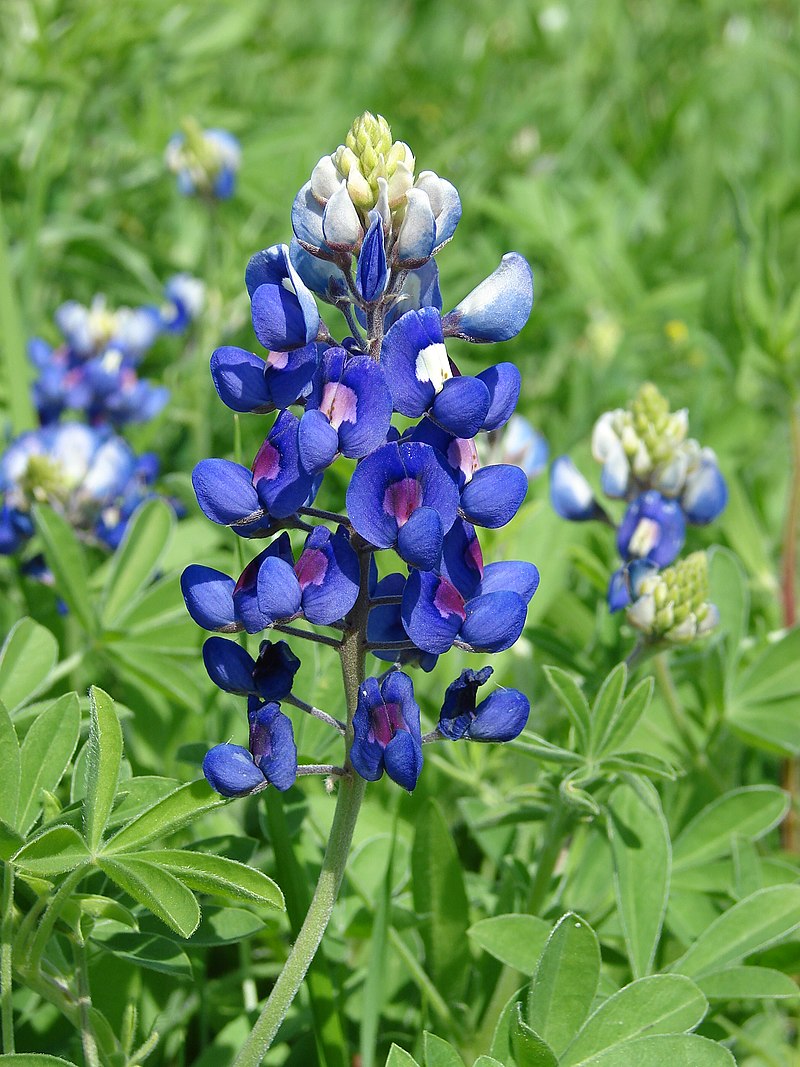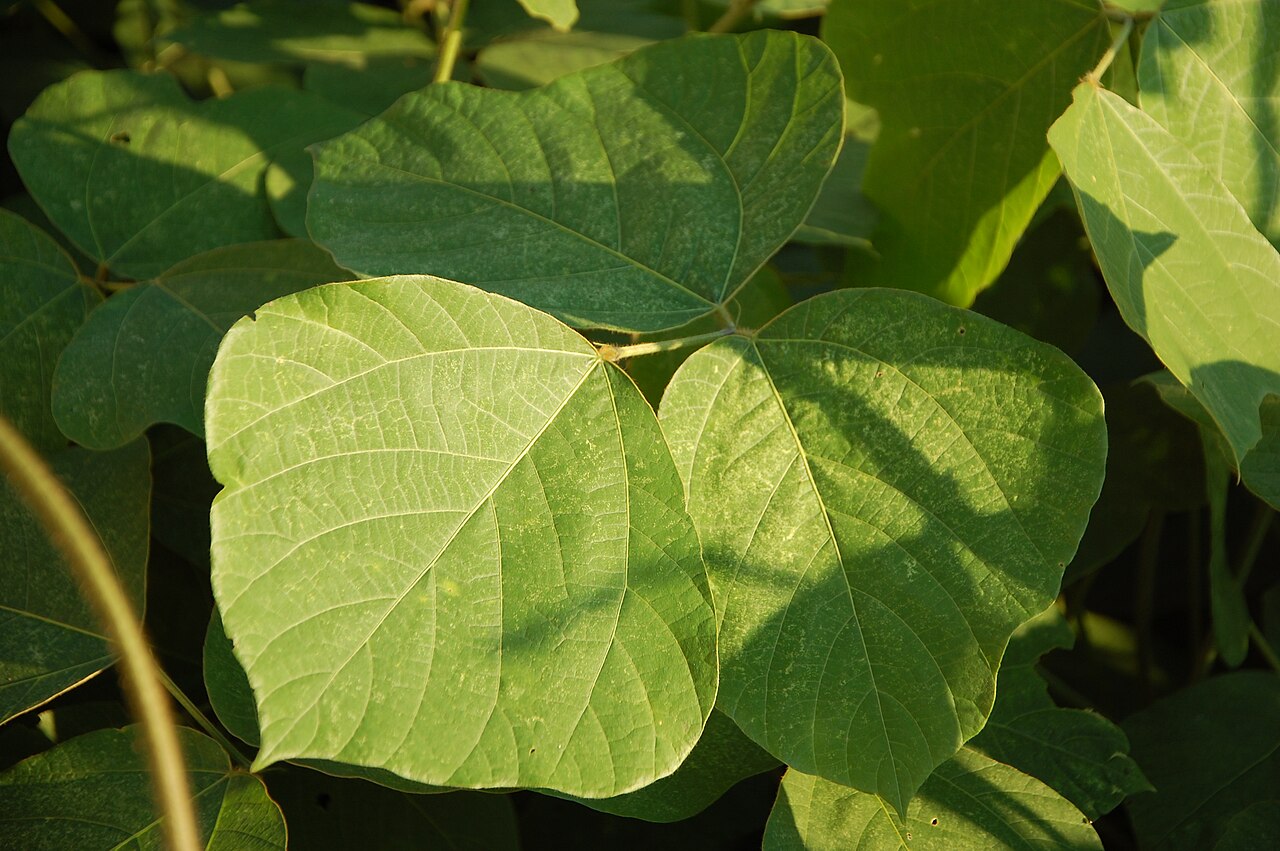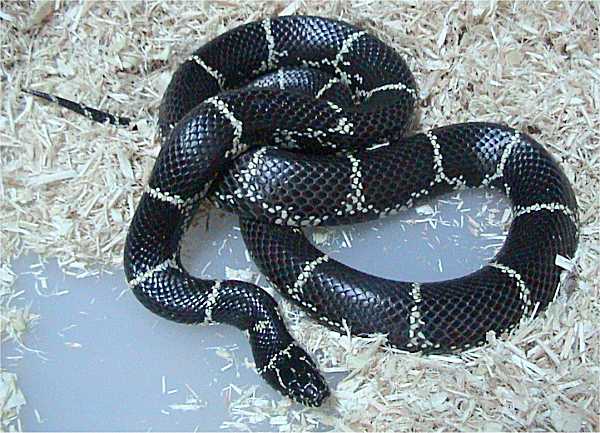Once again, toward the end of June, Route 23 was desecrated by poison spraying...to kill the wildflowers a wiser generation actually planted there. The lupines, I think, are completely gone now (and I liked lupines).
 |
| There are hundreds of species of lupines. Some of them even produce edible seeds. The ones planted along Route 23 in the 1990s were spikier, but this is a native Southern species many people like. This photo of a Texas Bluebonnet was donated to Wikipedia By Loadmaster (David R. Tribble). Also see his personal gallery at Google Photos - Own work, CC BY-SA 3.0, https://commons.wikimedia.org/w/index.php?curid=10100551 . |
 |
| There are many species of vetch, too. This European variety has fluffier flowers than the American white vetch along Route 23, but it's in the same general family--tall, narrow-leaved, weedy-looking plants with spiky-looking clusters of flowers rather than single blooms or round "crowns." Photo donated By Bernd Haynold - Own work, CC BY 2.5, https://commons.wikimedia.org/w/index.php?curid=867437 . |
Native plants tend to be well adapted to their environments and to displace non-natives. Right after the completion of this section of Route 23, in the 1970s, non-native crown vetch was planted as a safe but fast-growing ground cover. It still grows; its little round crowns of pink and white bloom still form a pretty backdrop, but the white vetch is crowding it back further every summer.
 |
| Crown vetch: pretty, useful to prevent soil erosion, hard to kill (with chemicals), but easy to displace (by encouraging native plants to crowd it out). Poisonous to horses, edible to cows. Photo donated By Daniel Gross - Own work, CC BY-SA 4.0, https://commons.wikimedia.org/w/index.php?curid=38223543 |
Then there are those sections along the guard rails where you'd think plants helping to hold the hillsides together, below the highway, would be most appreciated...but no. Idiots always spray poison there, and the effect on the vegetation that grows back, afterward, is definitely not what the chemical companies want people to expect.
This is a pathetic cell phone photo of a roadside area that has been sprayed with chemical "herbicides."
In real life, from that distance, you can clearly see...What's growing closest to the camera, front and center, is Johnson grass, which looks like young corn plants but is toxic to cows that eat it.
 |
| Johnson grass is closely related to sorghum, but seeds look very different from the species used to make molasses. Photo donated By Forest & Kim Starr, CC BY 3.0, https://commons.wikimedia.org/w/index.php?curid=6192566 |
The smaller plants around it are jimsonweed, which can be used to produce genuine temporary insanity, which may or may not be followed by long-term brain damage and/or death, in humans.
 |
| Jimsonweed in healthier, more mature condition than the measly plants in my snapshot, with blooms and seedpods. Photo anonymously donated to https://commons.wikimedia.org/w/index.php?curid=237684 . Details about the history and toxicity at https://en.wikipedia.org/wiki/Datura_stramonium . |
Further along the road are Spanish Needles, the little burs that stick through your clothes and prickle your skin if you walk through them. In places where this weed will grow when it's not been selectively encouraged by poisoning so many nicer plants, people do eat it, but they don't claim to like it. In Virginia, eating any Spanish Needles you find would be a very, very bad idea.
 |
| I suspect Wikipedia picked this image of a tropical variety from Midway Island because the flowers have visible petals. In Virginia the petals don't show nearly so well for so long, and the needle-shaped burs are much more conspicuous. Photo donated By Forest & Kim Starr, CC BY 3.0, https://commons.wikimedia.org/w/index.php?curid=6153528 |
The spray that killed the native plants around these three noxious weeds is thus actually promoting the growth of three of the most deservingly hated weeds in North America.
This is the natural vegetation about ten yards from the ecological disaster photographed above. In real life you can recognize the plants here, too. They've been mown rather than poisoned; in real life they're mostly healthy shades of green with yellow at the cut edges. They include crabgrass, dandelions, and red clover. They might be considered "weeds" in a garden but they're just what you want beside a road.
 |
| In war-torn Europe people have eaten crabgrass seeds; that's why this "large" crabgrass variety is sometimes nicknamed Polish Millet. Americans may never have been quite that hungry, but eating the small, uninviting seeds would be one way to control this garden weed! Photo donated By Rasbak - Own work, CC BY-SA 3.0, https://commons.wikimedia.org/w/index.php?curid=1053034 |
In my corner of Virginia we don't usually find a lot of Johnson grass, jimsonweed, or Spanish Needles. What nature intended to grow here are the more useful native plants. Dandelions, clover, burdock, chicory, plantain, daisies, buttercups, and less annoying species of Bidens will crowd out the evil weeds, and native fescue and sedgegrass will even displace nasty Johnson grass or Bermuda grass, when they get a chance. Only when people spray poison on our useful native plants do we see the really vile weeds take over.
 |
| When these lovely flowers dry out, they can be brewed into a tea that's known as one of the few plant sources of Vitamin B-12. Photo donated By Ivar Leidus - Own work, CC BY-SA 4.0, https://commons.wikimedia.org/w/index.php?curid=50438310 |
Kudzu and cinnamon vine are the only invasive species that choke out our native wild plants. I recently read an old novel that described a very young landscaper tackling kudzu the way the corporations advise--cutting the vines back to the ground, then painting glyphosate on the cut ends. While painting poison on target plants is much safer for humans and animals than spraying poison is (if I were running the Environmental Protection Administration, people could still get licenses to paint poisons), by now we've all seen what happens to fields where this approach to kudzu has been taken. There are farms that look like this...you can still see vague outlines of fences, equipment, and trucks beneath the kudzu growth.
 |
| What you get if you follow Monsanto's recommendations for kudzu control. Leaves die in autumn; new leaves sprout among old growth in spring. This is what certain properties in Scott County look like in April, but the clear photo was donated to Wikipedia By Rhododendrites - Own work, CC BY-SA 4.0, https://commons.wikimedia.org/w/index.php?curid=88927032 |
No. Actually there is a way to get rid of kudzu, for...exercise (I wouldn't say fun) and profit. You have to dig up the main roots. It's a day's work: if the roots don't strike bedrock they may grow twenty feet down below the surface, and they can be as big as your leg. But although cows and goats sometimes eat kudzu leaves, and people can make jelly from the flowers, the roots are the most useful part of a kudzu plant. Dried and powdered, they can be used like cornstarch or arrowroot to thicken the sauce in a stir-fry. Regular use of kudzu root starch in cooking is thought to help regulate blood pressure.
 | Kudzu. Photo donated By Bubba73 (Jud McCranie) - Own work, CC BY-SA 3.0, https://commons.wikimedia.org/w/index.php?curid=33772551 |
The main roots of cinnamon vines are "Chinese Yams" or "Japanese Yams." They don't taste like yams, sweet potatoes, or Irish potatoes, but if they're peeled thickly enough and soaked in vinegar for several hours, many Japanese and Korean people claim they taste good. They're certainly welcome to all of mine...but the point is, nature did not intend us to kill animals and harm humans by poisoning even these invasive "weeds." Wild plants have uses and the ethical thing to do with them is use them.
 |
| The species that's a nuisance in Scott County is Dioscorea polystachya, the Many-Fruited Cinnamon Vine, and are they ever "many-fruited." Let one vine go to seed and you'll be picking sprouts out of several square yards of lawn or garden...or else seeing those square yards covered in vines. Photo donated By James H. Miller, USDA Forest Service, Bugwood.org - This image is Image Number 2307129 at Forestry Images, a source for forest health, natural resources and silviculture images operated by The Bugwood Network at the University of Georgia and the USDA Forest Service., CC BY 3.0, https://commons.wikimedia.org/w/index.php?curid=18252361 |
Even the plants we find easiest to hate have their uses. Even Bermuda grass, loathsome though it is to gardeners, does tolerate heavy mowing and give that tacky oldfashioned Astroturf look to a "lawn." Personally I wish people who wanted Astroturf would just buy some and join the rest of the world in helping kill Bermuda grass, but some people do like looking at the stuff. And they'd even have a right to look at Bermuda grass...if they could keep it from spreading beyond their own property lines!
 |
| If you want a lawn that looks like this, why waste water, waste fertilizer, and spray poisons? This lawn wasn't very expensive. Sheets that will look like lush, close-cut Bermuda grass for years cost pennies per square foot...and instead of choking useful plants, they'll mulch the ground around the useful plants! Photo of the Astroturf Lawn Look done right donated by By ProGreenGrass - Own work, CC BY-SA 4.0, https://commons.wikimedia.org/w/index.php?curid=38355102 |
I don't like wild grapevines, and neither did the Bible writers, who expected everyone to relate to the disappointment of a person who had planted domestic grapes in a field that "brought forth wild grapes." However, people make things, wreaths and sometimes even baskets or hammocks, out of wild grapevines.
 |
| Wild grapes will eventually look like miniature grapes. They're edible, though not very palatable or nutritious. Photo donated By Vassil - Own work, Public Domain, https://commons.wikimedia.org/w/index.php?curid=2098262 |
I used to live near a park where the rangers didn't like chinaberries and phragmite reeds, both of which had invaded the park from suburban gardens. I don't mind either of those plants myself, but if you do, you should know that crafters find all kinds of uses for them. If I wanted to get rid of these or other introduced ornamental plants that have spread and become nuisances, I'd organize a crafts contest with a cash prize for the most inventive use of them.
 |
| It's possible that NASA chose to donate this picture of supersized phragmites from the Great Lakes, rather than the Greenbelt or nearby parks along the Anacostia River, because in Maryland the reeds never seem to grow quite that huge. Some scientists think there's actually a native variety that is easily crowded out by a more invasive foreign variety of what seems to be the same species. Photo donated By NASA Goddard Space Flight Center from Greenbelt, MD, USA - NASA Tracks an Environmental Invader, CC BY 2.0, https://commons.wikimedia.org/w/index.php?curid=81860613 |
If I wanted to get rid of crabgrass, I'd tear out the clumps it forms and sow fescue or sedge grass. (It's noteworthy that Wikipedia uses "sedge grass" to mean a different genus than what my elders called by that name.)These grasses grow taller, and will shade out crabgrass and even Bermuda grass if you let them.
 |
| Fescue in full bloom. Photo Public Domain, https://commons.wikimedia.org/w/index.php?curid=2740153 |
You don't want to get rid of clover, dandelion, dock, plantain, or daisies. When these plants grow right on the berms of busy highways they're not fit to eat, but they do absorb pollution and reduce soil erosion. When they grow in yards, near houses, they are food. They nourish many other creatures as well as humans, which is a good thing.
There are only a few plants for which nobody has ever found a good use. Three of them are Johnson grass, Spanish Needles, and jimsonweed. (Actually some historians believe jimsonweed was reintroduced to Europe and Africa by people who wanted a new way to commit murder...but though researchers have experimented with microdoses as cures for diseases, nobody has yet found a good use for jimsonweed.)
"You can't please everybody," wailed a local park manager. "I like the nice clean" (imitation Astroturf) look of that bank. It looks as if someone cares about it," which he must do, having mown that steep bank in the hot, humid weather we've been having. "It's not a scary, ratty, snaky look."
Americans need to re-educate ourselves to feel less fear of native plants and the other natural inhabitants of our natural environment. The kind of rats and snakes you might have been trained to fear do not live in my not-a-lawn, although my family have been encouraging useful native plants to choke out any invasive Bermuda grass that might creep in, for many years, and some years the ladies' thumbs "grass" does grow four feet high. The main reason why we've never had problems with undesirable rats and snakes are (1) the resident snake, and (2) the cats. If you don't entertain morbid fears of cats and the friendlier kinds of snakes you won't have to worry about vermin lurking among native plants, either.
 |
| Though scientists are currently debating what its Latin name ought to be, there's nothing "obsolete" about this common, harmless snake. The Black Rat Snake is the "climbing" species properly called gulegi in the Cherokee language. They're not venomous (though the big ones can chomp). They're not social; apart from occasional mating visits their only interest in other snakes is eating them. (The myth that they mate with venomous snakes comes from the difficulty some people have in telling exactly what snakes are doing.) They can grow big enough to eat a dumpster rat. They usually avoid humans. If you live near one of these snakes you'll probably never see a venomous snake. Photo donated By Judy Gallagher - https://www.flickr.com/photos/52450054@N04/6936274620/, CC BY 2.0, https://commons.wikimedia.org/w/index.php?curid=54266563 |
 |
| The Black King Snake is a little showier, less common, and less likely to grow more than a yard long, although it can. The more common variety of King Snake where I live has bands of light brown and tan. Other species have other patterns--some even ringed with red and black, like poisonous coral snakes. But they don't harm humans. They don't let inferior kinds of snakes harm humans, either. Their favorite food is a smaller snake. Photo donated By en:User:Dawson - Own work, CC BY-SA 2.5, https://commons.wikimedia.org/w/index.php?curid=1518737 |
By itself a taste for the dowdy Astroturf look might be considered harmless, like a taste for red over white roses or vice versa. However, we really can't afford to indulge any landscaping tastes that depend on spraying poisons on the land. Dead songbirds, or sick people, or even learning-disabled children, need protection in a way a garden look does not. We all need to learn to appreciate the beauty of clover, dandelions, and chicory.
The result of a phobic reaction to these pretty, useful native "weeds" is--really nasty weeds.


No comments:
Post a Comment